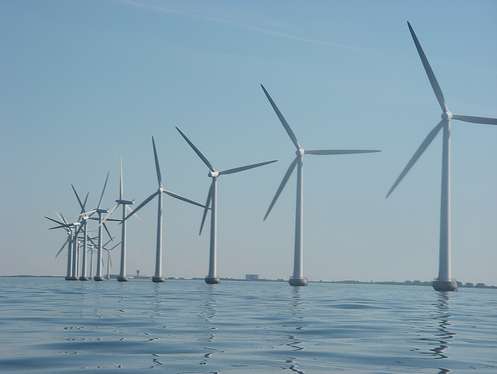The US has lagged behind European countries in capturing offshore wind for electricity, but a spate of recent studies suggest that a bigger push might be in order.
The latest, from Stanford civil & environmental engineer Mark Jacobson concludes that offshore areas of the East Coast alone have enough moving air to meet a third of the entire nation’s energy needs.
Running out the string quite a bit further, studies from Stanford and Lawrence Livermore National Lab point to a breezy bounty offshore and at higher altitudes that could theoretically power the planet, perhaps as soon as 2030.
The US has lagged behind other developed countries in capturing offshore wind for electricity.
Credit: NC State University.
Of course, that would take four million powerful turbines.
“If we put half over the ocean and half over land, we’d need about 0.6 percent of the world’s land for turbines,” Jacobson told listeners to KQED’s Forum program this week. “But all of that land, almost, is open space between the turbines, that can be used for multiple purposes, including rangeland, cropland, pasture land or just plain open space. The rest is over the water.”
Offshore turbines have several advantages over the wind farms that we’re used to seeing from the freeway. They can be mostly out of sight and earshot, for one thing, and are also likely to be a steadier source of power than most land-based “wind energy resource” areas. Looking at one area off Cape Mendocino, California, a Jacobson study from 2010 noted that offshore winds were “consistently fast throughout the day and night during all four seasons.”
“California has a tremendous offshore wind resource,” said Habib Dagher, who joined Jacobson and other experts on the program. Dagher, who runs the DeepCWind Consortium at the University of Maine, calculates that within 50 nautical miles of the California coast is about 587 gigawatts of untapped energy, the equivalent of more than 500 commercial nuclear power plants. The tricky part will be tapping it. The ocean depths off of California would likely require a whole new generation of turbines that ride the waves like big buoys.
In March, Dagher’s group will place an experimental floating turbine off the Maine coast. The scale-model test will offer insights into how giant six-megawatt turbines would perform offshore. He says research and development funding doesn’t support a bigger push right now, that the Energy Department’s wind research budget hovers between $70-80 million per year, “very small” compared to what much smaller countries are spending. Dagher says the U.K., for example, is aiming to get a quarter of its electricity from offshore wind farms by 2020.
“The offshore component opens up significant areas, added Dan Kammen, who heads the Renewable and Appropriate Energy Lab at UC Berkeley. “The marine environment is challenging and to make [those] systems work, we’re gonna need to really invest in it. The U.S. has been a bit slow in this regard.”
Dagher says that while conventional onshore wind farms are already cost-competitive with some fossil fuels, offshore development is about twice as pricey.
“These technologies, on a resource basis, are very much ready to compete,”said Kammen. “We just need to give them that shot.”
Craig Miller is a multimedia producer for KQED Climate Watch, a Climate Central content partner.
This article was syndicated from Climate Central. Reproduced with permission.











